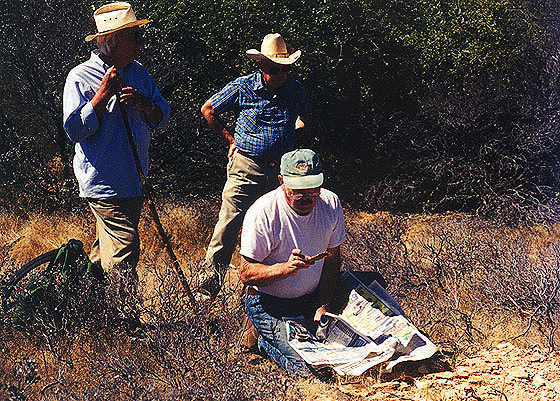
|
Here's a scan of a photograph taken on August 19, 2000, during a field trip to the "Lygodium Gulch" locality (named after the rather common to abundant remains of a fossil climbing fern found there, Lygodium kaulfussi) in the Middle Eocene Ione Formation, Ione Basin, California. The late paleobotanist Dr. Jack A. Wolfe is kneeling, examining a fossil leaf specimen before he wraps it in sheets of newspaper for safe transport to the archival paleobotanical collections at the University California Museum Of Paleontology in Berkeley. My late father, an Engineering Geologist, looks on in the blue plaid shirt behind Dr. Wolfe, while paleobotanist Howard Schorn (with the walking stick in hand), gazes to the scenic countryside all around us. Image was taken on August 19, 2000. Please note: All fossil localities in the Ione Formation of Amador County, California, presently occur on private property; explicit permission from the land owners must be secured before collecting fossils there. In the year 2000, scientific interest in the fossil floras of the Ione Basin increased with exponential intensity when paleobotanists Dr. Jack A. Wolfe (passed away in August, 2005--former member of the United States Geological Survey) and Howard Schorn, among others, applied for a National Science Foundation Grant to study the many prolific Eocene fossil plant localities of the western foothills of the Sierra Nevada--their goal was to determine the paleoelevations and associated paleoenvironment of the ancestral Sierra Nevada region during the early Tertiary Period (Eocene geologic times). The Ione Basin fossil floras had now assumed a broader scientific significance, providing as they did an essentially sea-level Eocene flora in the western foothills of the Sierra Nevada--fossil plants from the estuaries, rivers and floodplains adjacent to a vast inland sea that had flooded what is now the Great Central Valley of California during Eocene times (roughly 50 to 40 million years ago). Such a sea-level flora could provide an invaluable baseline reading to help establish an accurate determination of the ancestral Sierran paleoelevations and paleoenvironment during the Eocene Epoch of the Cenozoic Era. Another field trip to the Ione Basin was now in order... In early August, 2000, Howard Schorn sent me an email regarding another potential day's expedition to the Ione Basin. For a week in mid August, he would be visiting the classic Eocene fossil plant localities in the auriferous gravels around Grass Valley/Nevada City, western foothills of the Sierra Nevada, with fellow paleobotanists Dr. Jack A Wolfe and Dr. Bruce Tiffney (a professor at the University Of California Santa Barbara who specializes in fossil seeds and fruits). They wanted to refamiliarize themselves with the local geology, stratigraphy and paleobotany of the ancestral Eocene Yuba River fluvial system--the great aggrading collection of rivers that had deposited the world-famous auriferous, gold-bearing gravels in the northern Mother Lode district of California--gravel-boulder deposits that had produced millions of dollars in gold (at the old meager price of 20 dollars per ounce!) through open pit hydraulic mining methods during the mid to late 1800s. Today, the great hydraulic pits remain inactive, but exposed within their vast, ghostly confines lie beds of so-called "chocolate" shales (named for their distinctive coloration in the field) which yield one the greatest accumulations of Lower-Middle Eocene plants on Earth. This is what paleobotanists call the Chalk Bluffs Flora that has been collected from virtually every abandoned hydraulic gold mining pit in the western foothills of the Sierra Nevada. It yields over 70 species of fossil plants; it is perhaps North America's premiere Lower to early-middle Eocene fossil flora. And it is the flora that Dr. Wolfe, Howard Schorn and others hoped to study to help determine the paleoelevations and paleoenvironment of the ancestral Eocene Sierra Nevada. Also on the planned itinerary was a visit to my newly discovered fossil plant localities in the Ione Formation of the Ione Basin. Howard Schorn wanted Dr. Wolfe to take a look at a least a couple of the more accessible and productive sites to determine whether the Ione Basin Flora should be included in the proposed NSF grant study. Naturally, I was most-enthused about the possibilities of taking the paleobotanists to the fossil sites in the Ione Basin. This was a dream come true, indeed. I made the necessary arrangements with local landowners and eagerly anticipated the call from Howard. The call came in on the evening of August 18, 2000. Howard phoned me from his motel room in Nevada City, in the heart of the northern Mother Lode district. The paleobotany group was on their proverbial last legs of the fossil tour to the abandoned hydraulic mines. And now the time had arrived to investigate the Ione Basin floras. I told Howard that everything was good-to-go. All systems were ready for "blast-off," as it were. Howard explained to me that evening that he was especially interested in showing Dr. Wolfe the specific locality that later became famously known as "Lygodium Gulch," named after the rather common to abundant remains of a fossil climbing fern found there, Lygodium kaulfussi, whose closest modern counterpart is the living climbing fern, Lygodium palmatum, native to the southeastern and eastern United States (it has been reported from Mississippi, Alabama and Georgia north to New England). No problem, as the saying goes. We had the landowner's permission to visit. With great anticipation, I awaited the coming morn... |